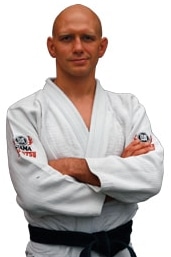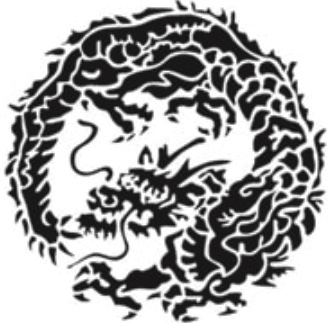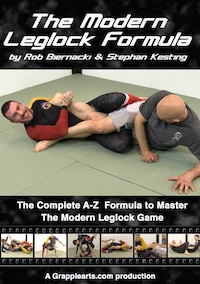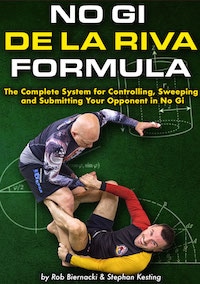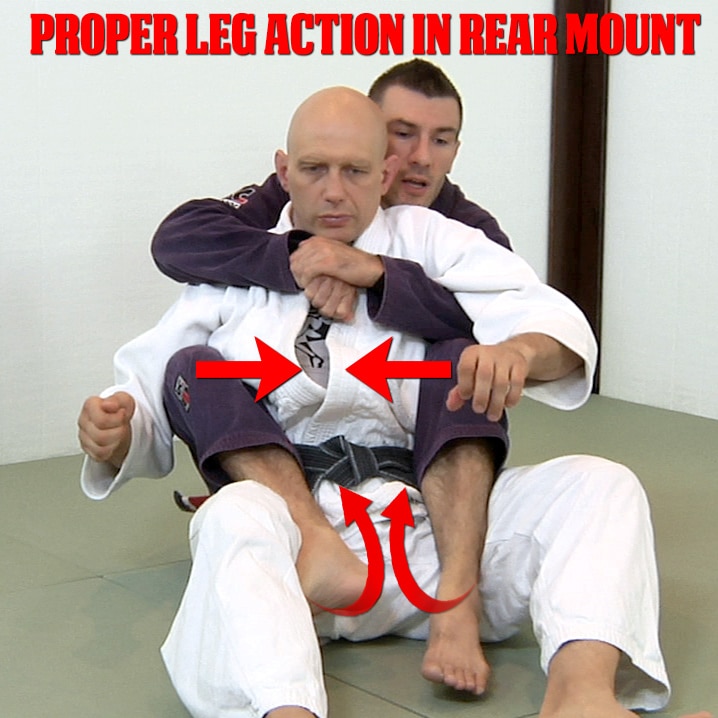
The rear mount is one of the very best positions you can get in BJJ.
In rear mount you’re behind your opponent and can attack him with chokes and armlocks (not to mention strikes in an MMA or self defense context). And there’s pretty much bugger all that he can do to you…
But it can be a lot of work to get here. You have to pass his guard, induce him to turn, secure your grips, get your hooks in, etc. etc. Having spent all that energy to get to rear mount you definitely DON’T want him to escape, so once you achieve it then knowing how to maintain this position is ultra-important.
Fundamentally there are two things controlling your opponent in rear mount:
- Your arms,
- Your legs
I’ve made videos and written about the importance of upper body control in rear mount, for example how to apply the over-under grip (aka the harness or the seat belt) correctly and how Emily Kwok approaches gripfighting from the rear mount.
Gripfighting and arm positioning in the rear mount is incredibly important – but that’s NOT the focus of today’s article…
Today I want to talk about a lesser known aspect of rear mount: namely how the legs help control your opponent. And it’s an aspect of the position that many people are doing incorrectly.
The legs really help limit your opponent’s mobility. They can stop him from rotating side to side, shifting from your strong side onto your weak side, and even make it a little hard to breath.
With the help of Rob Biernacki – a friend and one of my coaches – let’s first look at an incorrect use of the legs.
What happens if you just put your hooks in without applying any pressure or control with them?
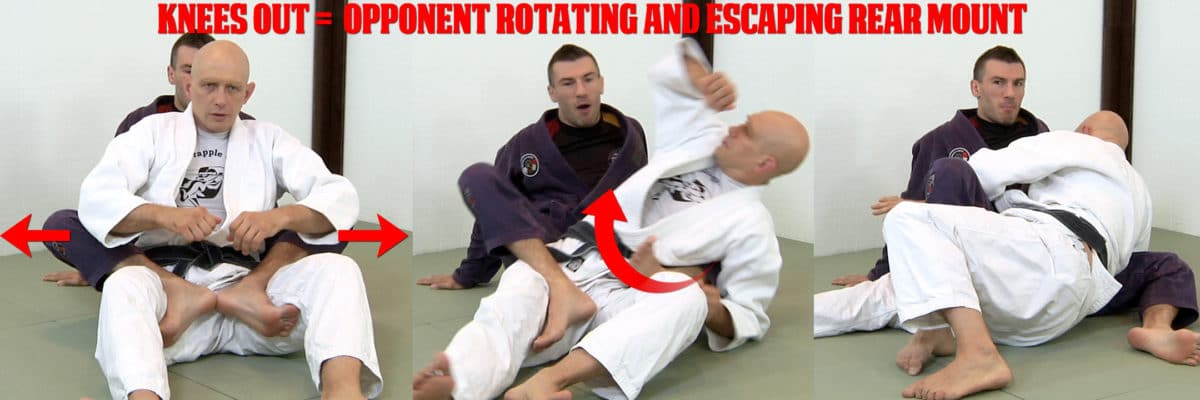
In the photo strip above Rob Biernacki has me in rear mount using only his legs. But his knees are angled outwards and there’s no pressure on my body.
This lack of pressure allows me to shift to the side and turn in to face him. I end up in his guard, and all that hard work he did to get to rear mount is now down the drain!
You see this happen all the time in BJJ, MMA and submission grappling. A violent spin ending in the guard, and a formerly dominant position now becoming a neutral position (at best).
But there’s an easy way to make this much less likely. And to do that let’s look at how to use your legs correctly…
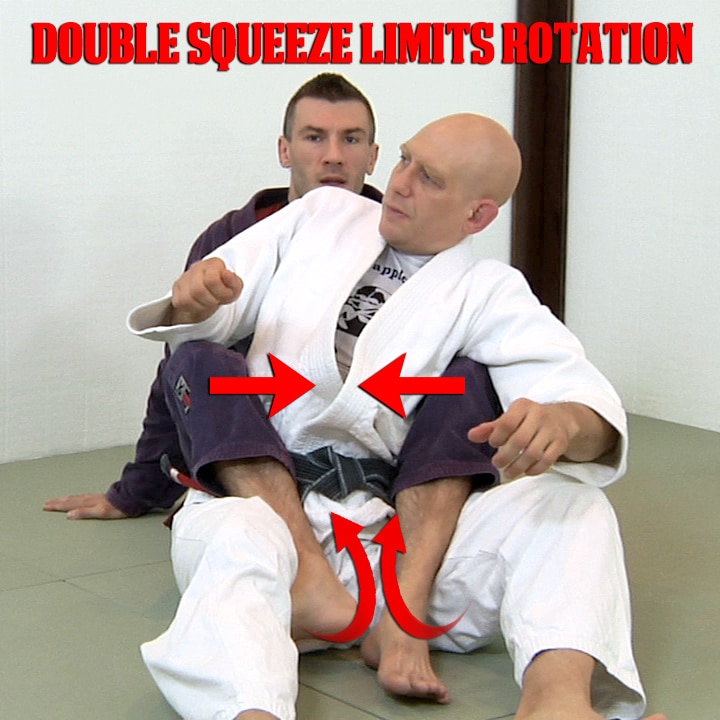
The key is generating pressure with your legs. And there are two types of pressure, both of which stop your opponent from spinning and moving…
Firstly, in the photo above Rob’s knees are pinching inward. His knees are against my floating ribs: it’s not a submission, but when we took this photo for me it felt slightly uncomfortable and just a little bit hard to breathe.
Secondly, in the new, improved version Rob’s heels are pulled in towards his own butt. This hamstring curl motion really keeps his heels and calves tight against my legs.
These two actions together to hugely limit my mobility. Rob doesn’t have upper body grips in the picture above, but even without that it’s really difficult for me to shift from side to side, and almost impossible to turn and face him.
Try this exercise: grab a training partner, put him into the rear mount, and then apply the double squeeze (knees in, heels back). He should really notice the difference. Then change places and have him do it on you.
Once you’ve felt the effects of this double squeeze action you should become a convert in no time.
When you take the proper leg pressure and add good arm positioning back in then your rear mount will look something like this…
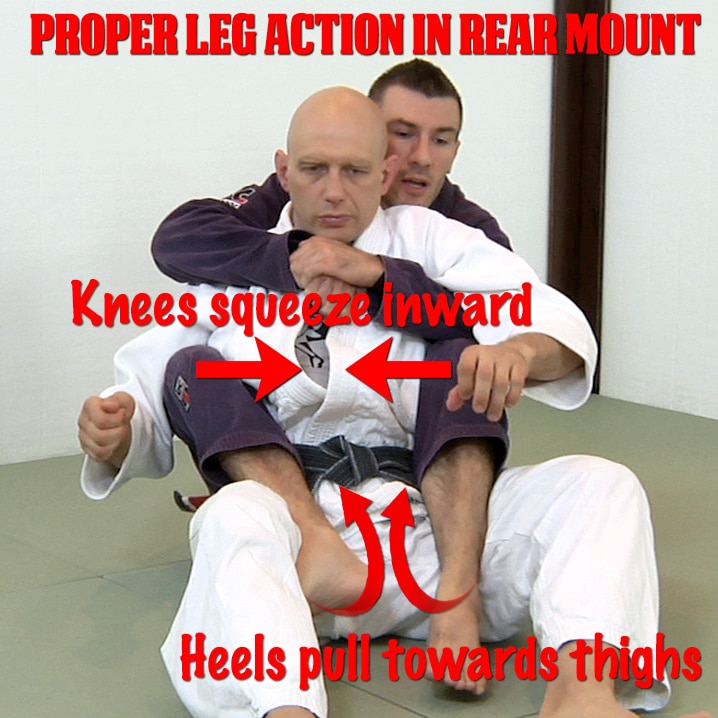
In this form of rear mount – combining your grip AND your hooks – you should have total body control over your opponent. He won’t be going anywhere, and dislodging you from his back should be MUCH more difficult.
Plus by keeping him in the line of fire (i.e. directly in front of you) and spending less energy fighting his escape attempts you can keep your focus on submitting him, which is, of course, the ultimate the goal of BJJ.
Jiu-jitsu is a whole body art so don’t do rear mount with only half your body. Get your harness upper body grip and combine it with the double squeeze of your legs: life just got better for you and much worse for your opponent!
More Rear Mount
In this article we’ve just covered the basic leg positioning for the rear mount. So now you can do that correctly – great! But another HUGE variable for the rear mount is which side to fall to.
In BJJ we refer to the ‘strong’ and ‘weak’ sides of the rear mount.
Here’s an entire instructional that Rob Biernacki and I put out for free about attacking and maintaining the weak side of the back.
It’s available for free both as a long youtube video, and broken up into chapters as a free module in the Grapplearts BJJ Master App for iPhone and Android.
Check it out – your jiu-jitsu will thank you!
More Rob Biernacki
I’ve worked with Rob quite a bit over the years and in addition to a ton of free stuff we’ve also released a series of best-selling instructionals.
These include…
These instructionals are supremely well organised and among the most informative BJJ videos ever created. Which is why they all come with a 365 day unconditional moneyback guarantee.
Click on one of the links in the list above for more info on that particular instructional!

